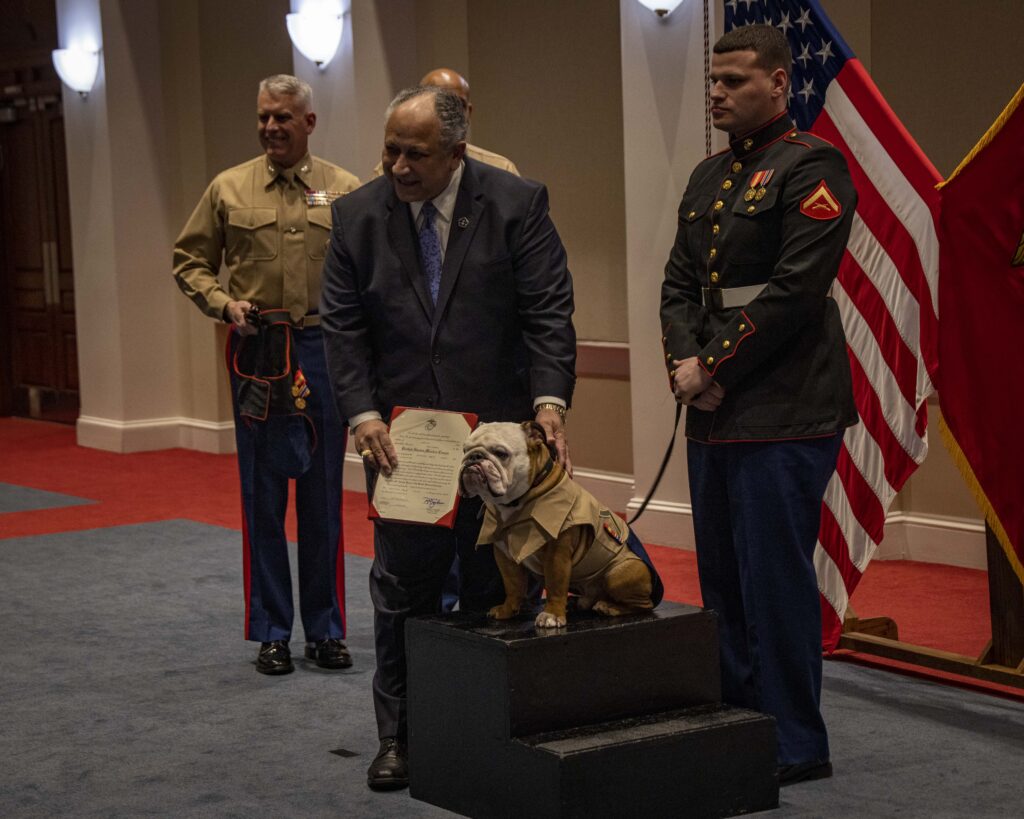
In a momentous ceremony at Marine Barracks Washington last week, presided over by Secretary of the Navy Carlos Del Toro, Chesty XVI, the official mascot of Marine Barracks Washington, was promoted to the rank of Lance Corporal.
“At a time when our nation is being challenged in many different ways, we need Marines like each and every one of you to represent everything that’s great about this country,” Del Toro said. “And Chesty XVI represents everything that’s great about the Marine Corps.”
After the Battle of Belleau Wood, U.S. Marines adopted the moniker “devil dogs,” a term believed to have originated from the defeated Germans who, in awe of their tenacious adversaries, allegedly referred to them as “teufelhunden,” meaning hell hounds. Following World War I, the nickname gained prominence and began to feature prominently on Marine Corps recruitment posters, often accompanied by an iconic depiction of a scowling, helmet-clad English bulldog, symbolizing the indomitable spirit of the Marine Corps. While the nickname played a significant role in shaping the Marine Corps identity in the 20th century, it’s worth noting that there isn’t evidence to confirm its origin as a reference to the Marines by German troops.
Chesty XVI’s Pup Predecessors
During his tenure as the commanding officer of the Marine Barracks at Quantico, Virginia, Brig. Gen. Smedley D. Butler extended the nascent tradition by enlisting “Private Jiggs” into the Marine Corps on Oct. 14, 1922. Jiggs was born in Philadelphia on May 22, 1921, and boasted an impressive pedigree. The mascot experienced rapid promotions within the ranks, attaining the position of Sergeant Major on July 17, 1924.
Remaining true to custom, the Barracks welcomed Private First Class Chauncy into its ranks in 1956. Following Chauncy, Chesty I assumed the mantle, bearing the name in homage to the legendary Marine Lt. Gen. Lewis “Chesty” Puller, the most decorated Marine in the history of the Corps. Chesty I made his debut during the very first Evening Parade on July 5, 1957.
Over the years, numerous English bulldogs have faithfully served at the Barracks, with some receiving formal burial honors within the Barracks’ hallowed grounds. This enduring tradition underscores the profound connection between legend and the fighting spirit of every Marine, past and present.
Former U.S. Marine Keith Burns, who served as a Marine Barracks Washington mascot handler in 1998, had the opportunity to escort Chesty XI to the 80th anniversary of the Battle of Belleau Wood.
“As this battle was the birthplace of the mascot’s role, being there 80 years later with our mascot was humbling and awe-inspiring,” said Burns. “Being part of an ongoing tribute to our history and moniker of ‘devil dog’ made me feel even more connected to the Corps and served as a reminder of how our past continues to shape our present, and future.”
Chesty XVI enlisted in the Marine Corps February 2022. He relieved Chesty XV of his duties on May 6, 2022, and marched in his debut parade that evening.
Chesty XVI’s promotion to Lance Corporal not only embodies the Marine Corps’ legacy but also highlights the mission of Marine Barracks Washington to represent the Marine Corps to the nation. The “Oldest Post of the Corps” continues to stand as a keeper of tradition and beacon of the Marine Corps’ values, inspiring patriotism and showcasing the unwavering commitment of Marines who have served, are
- Pacific Marines, Philippine Marines Meet for Annual Staff Talks - February 16, 2024
- Chesty XVI, Mascot of Marine Barracks Washington, Promoted to Lance Corporal - January 23, 2024
- BAE Systems Delivers First Production-Ready ACV Command Variant to U.S. Marine Corps - January 12, 2024



